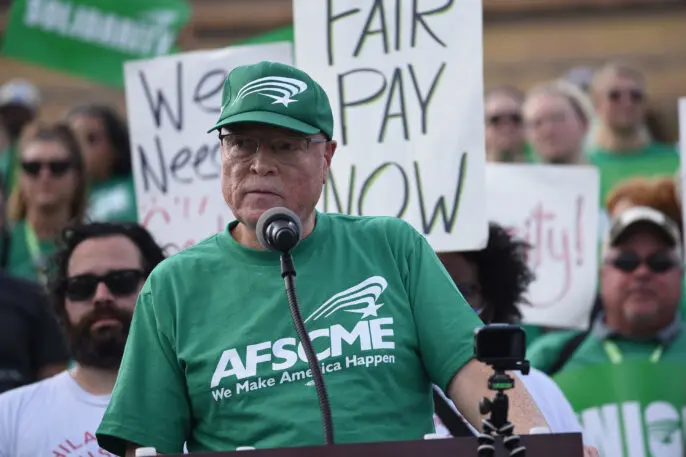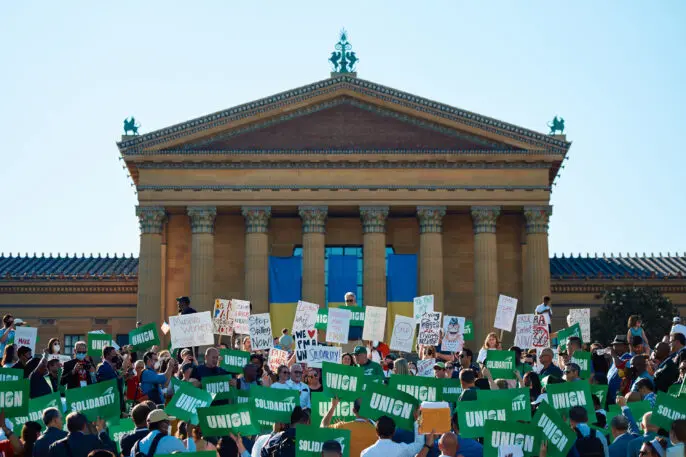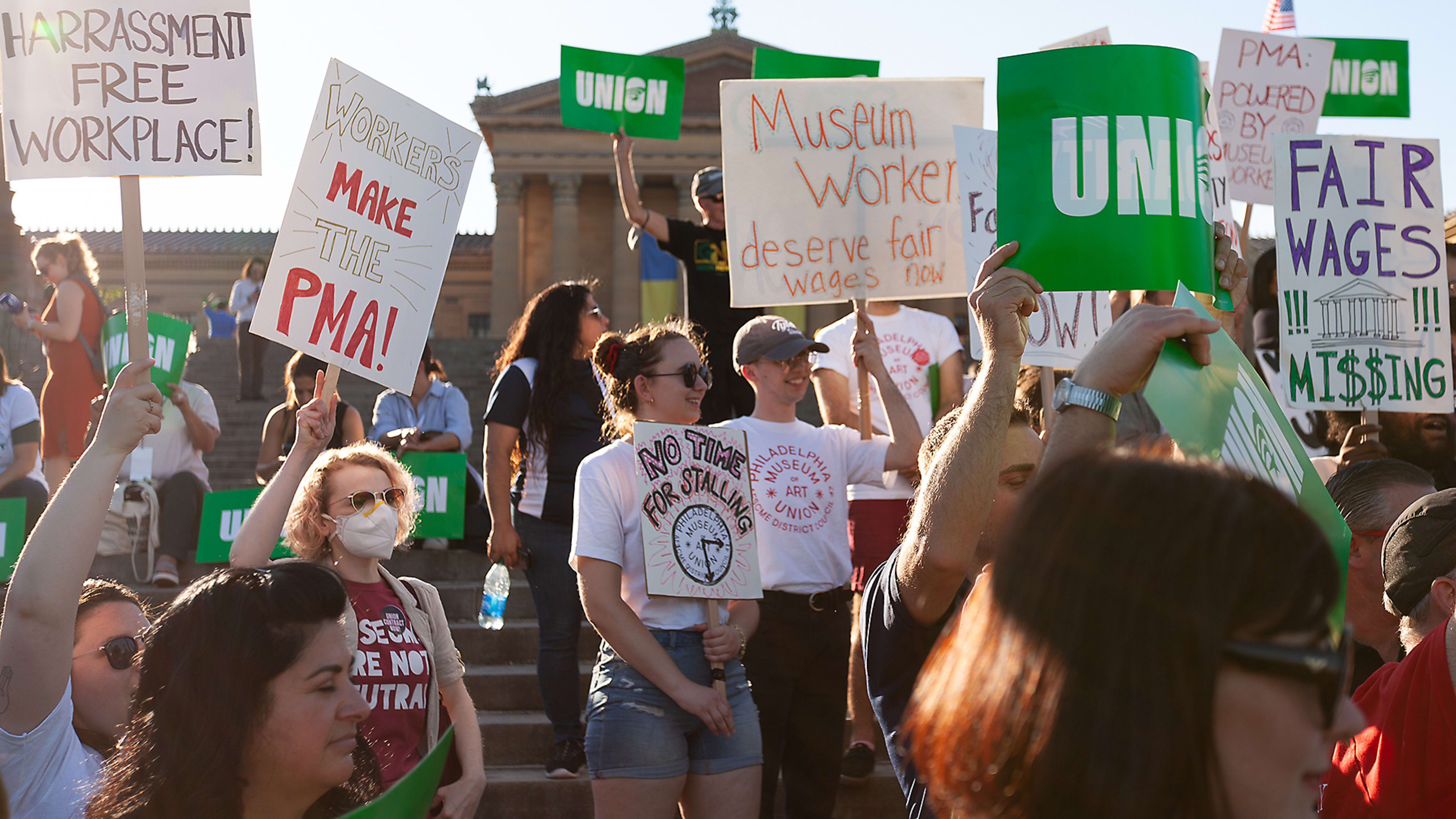It’s mid-June, and Lee Saunders, president of the American Federation of State, County, and Municipal Employees (AFSCME) union, is speaking so loud into the microphone that it’s slightly distorted, and someone has to go over and tweak the dials on the PA system so his booming voice comes out clearer.
He’s telling the crowd in front of him to get fired up, and they are: hundreds of people in green AFSCME T-shirts, who minutes before had filed out of buses that came from the AFL-CIO convention, an event for the nation’s largest federation of unions held every four years. “We are here to send a very, very strong message,” he says—and someone in the crowd immediately echoes him, shouting, “Strong message!”
AFSCME is a public service union, representing sanitation workers, school bus drivers, nurses—the types of jobs you might typically associate with unions. But this rally isn’t for them, even though some of the audience members in their AFSCME or AFL-CIO T-shirts in the crowd surely work in those jobs. Nor is it a rally for Starbucks or Amazon, private-sector union efforts that have garnered much of the recent media attention on the labor movement. Saunders is speaking to the crowd from the steps of the Philadelphia Museum of Art (PMA), flanked by signs that read, “The art might be priceless, but the labor isn’t. Pay up,” and “Put your Monet where your mouth is.” PMA workers first unionized two years ago, but have yet to settle on a contract with management; Saunders, and the union workers who have crowded around the museum steps, are here to demand one.
After testimonies from museum workers—who spoke of their experiences with harassment, retaliation, and the contrast between the museum’s $60 million budget and recent $233 million renovation and the fact that workers haven’t received raises in years—Randi Weingarten, president of the American Federation of Teachers (AFT), took the mic. “We need our museums to thrive,” she said, before announcing that AFT was giving $5,000 to the museum workers’ strike fund (though workers say they are not planning to strike, a fund helps them show museum management that they could if they needed to, to get a contract in place).
Immediately, the other labor leaders present followed suit, including the AFL-CIO and, of course, AFSCME, for a total of $25,000. Some museum workers were teary-eyed. “It really is a union doing something together, and recognizing that you have more power as a collective than any of us do as individuals,” said Nicole Cook, a program manager for graduate academic partnerships at PMA. A month later, when AFSCME was holding its own convention in Philadelphia with more than 3,000 workers, the union held another rally and announced another $25,000 contribution to the PMA strike fund.
The idea of “the labor movement” can feel amorphous, something happening in the background that most workers—even ones in unions—are disconnected from. But on the steps of the museum, that movement became visceral. “We want the PMA workers to know that they are not alone,” Saunders says into the mic, a sea of green AFSCME T-shirts in front of him. “They are part of a proud union, we call it the Mean Green Machine. They are part of the AFL-CIO family—millions of workers across this country.”
Sitting down for an interview the following day, Saunders noted that the union support those workers felt at that event was “what the labor movement was all about—coming together, all of us supporting one another who have the desire to organize.” PMA is just one example of a surge in cultural institutions that have been unionizing with increasing fervor in the last few years, part of a campaign by AFSCME to offer support for these sectors to join their ranks.

Cultural Workers United
When he was offered a job at the PMA in 2014, Adam Rizzo, a museum educator and now president of AFSCME Local 397 (which PMA workers helped charter to represent cultural workers in Philadelphia), said he jumped at it “because there’s this idea that there’s always 20 people behind you waiting to get their foot in the door and do it for less money. . . . There’s some sort of prestige that comes along with it. You’re doing this important work, but I certainly internalized this idea that I don’t do this for the money, so of course I didn’t even know how to advocate for myself in the workplace because of that.”
When a crowdsourced spreadsheet of museum salaries went viral, collecting museum salary-and-benefits information for transparency, it revealed just how lacking those wages were. Not only were they “wildly depressed across the industry,” Rizzo says, but there were disparities within PMA itself, including among colleagues at the same level.
That spreadsheet opened conversations and created the beginnings of union organizing. “We didn’t go into organizing thinking we were organizing,” Rizzo says. “We were just meeting sometimes at bars after work, talking about workplace issues, and we realized we’re organizing a union here.” As workers were about to go public with their union cards, the world shut down for COVID-19, and their organizing work was moved to Zoom. But they kept going. PMA workers voted to unionize in the summer of 2020, forming the first “wall-to-wall” union in a major American museum, meaning that every department, professional and nonprofessional workers, are in the same bargaining unit.
It’s one of many recent firsts for AFSCME when it comes to cultural workers organizing: In January, workers at the School of the Art Institute of Chicago voted to unionize, becoming the first major Chicago art institution to do so. When the Daniel Boone Regional Library system in Columbia, Missouri, unionized in May 2022, it became the first unionized library in the entire state. And in June, after 18 months of negotiations, Boston’s Museum of Fine Arts (MFA) won its first union contract. In 2020, according to a year in review report for 2021, that was a “banner year” for AFSCME’s Cultural Workers United campaign; and included not only new union efforts and contracts, but also a report about how cultural institutions took federal PPP money, but still laid off workers.
The AFL-CIO largely has a goal of adding 1 million new union members over the next decade, and AFSCME’s work with cultural institutions is a big part of that effort. Still, much of the momentum is coming from the workers themselves—particularly young people—who are inspired by the prospect of a union, Saunders notes, pointing to a 2021 Gallup poll that found that 77% of young adults approve of unions. Recent numbers from the National Labor Relations Board (NLRB) show that the unionizing wave we’ve seen across industries in the past two years doesn’t seem to be slowing: During the first nine months of fiscal year 2022, petitions filed to the NLRB for union elections have increased 56%; by May 2022, there were more petitions filed this fiscal year than in all of 2021. “They’re doing it, and then they’re reaching out saying we’ve got folks here who want to unionize—support us. And we jump right into this work,” Saunders says.
That was the case with the Daniel Boone Library. Tori Patrick, a worker there, said organizing began with coworkers talking about safety and fairness after the library reopened in 2020 and forced workers to interact with the public in the early, confusing days of the pandemic—with little guidance or support for the mistreatment they faced. After googling what unions would even work with public libraries—they had no idea where to start, Patrick says—they found AFSCME, filled out an online form, and set up a call. “None of us knew what to expect, none of us knew how seriously to take this,” Patrick says. “But in that meeting, the organizer we were speaking to told us that just by setting up this meeting, by having that call, we already started to organize. And that was really empowering to hear, and made it really easy to keep moving forward and take the next step.”

“A lot of this is homegrown”
AFSCME has nearly 1.4 million members and also represents nurses, school bus drivers, correctional officers, childcare providers, and sanitation workers. Cultural workers, says Saunders, fit right alongside those other jobs. Saunders himself came from what might be considered a more “traditional” union upbringing: His father was a city bus driver and part of the Amalgamated Transit Union in Cleveland, Ohio; his mother became a community college professor and a member of the American Association of University Professors.
He says he first came into contact with cultural workers in a union setting in the late ’90s and early 2000s, when he was the leader of AFSCME District Council 37 in New York City, and he noticed that some of the strongest advocates in the union were workers at museums, zoos, and libraries. He joined Ray Markey, president of the union that represented more than 1,800 librarians across the city, for meetings with management, where Markey kept pushing for benefits, and his workers’ demands. “It opened my eyes as far as some of the issues they were faced with,” Saunders says.
They were issues common to other sectors where unions are strong: workers didn’t have a voice, or believed they were being ignored or not listened to by management. That feeling was prominent in 1969, when cultural workers formed the Art Workers’ Coalition to pressure museums into reforms, like including more diverse exhibitions and free admission days. It was prominent in the early 2000s when the New York Public Library denied raises, even as librarians were fleeing to the suburbs for higher pay.
And it’s been especially potent these past few years when the pressures of the pandemic, a spotlight on diversity and inclusion via Black Lives Matter, and rising living costs have all intersected. Cultural workers were left feeling like they’re being steamrolled by managers who ignore their safety concerns or calls for inclusion while also raking in disproportionally bigger salaries and spending millions on new spaces.
AFSCME has represented cultural workers for years, but recently, Saunders says, there’s been a clear desire by these workers to unionize—an effort driven by the workers themselves. “A lot of this is homegrown,” he says. “They’re doing it and then reaching out and saying ‘support us.'”
Some of those issues revolve around better pay or healthcare. For others, it’s about simply having a voice in their workplaces—especially since these cultural institutions play an important part of the societal fabric of their cities yet made unilateral decisions during a pandemic without considering their workers. “I think that it’s a perfect storm of people really expecting workplaces to live up to the values they espouse, whether around [diversity] initiatives, whether around transparency and communication,” Rizzo says. There were incidents at PMA of harassment that went public, he notes. Also, the pandemic highlighted the need for job security and set raises, which a union contract can facilitate, along with the need for health and safety measures. “Workers are just really now demanding that their museums live up to their promises.”
Kait Roelofs, who works at the School of the Art Institute of Chicago, which began organizing in November 2020, says staff layoffs helped put urgency behind their efforts. “When you work at historical institutions like this, it’s hard to imagine it being any different than it is,” she said. “You get stuck underneath the legacy of the institution, under its history, and it becomes very difficult to imagine it being different, even though you want it to be different so badly.”
The actual work of unionizing cultural institutions may look different than in other fields, too. Roelofs notes that cultural institutions, particularly museums, often have to at least appear to be progressive. In thinking about their public perception, they may not come down as hard with union-busting language as, say, Amazon. But instead, she adds, they would fight back by attempting to prevent workers with some titles from joining the union, or use “softer language” about how workers didn’t need a third party coming between them. That’s why the organizing efforts have played to these institutions’ public perception. “Cultural institutions are very concerned with their image, ” she says.
At the Philadelphia Museum of Art, workers still don’t have a contract—but they’re still continuing to move forward. “It is not hyperbolic to say our union’s fight for a fair contract . . . is a fight to save one of the world’s great art museums,” the union tweeted in early August. And what’s crucial, they are not alone. Since that second rally on the museum steps, even more cultural workers have organized: the Academy Museum of Motion Pictures voluntarily recognized its workers’ union, the Baltimore Museum of Art overwhelmingly voted to form a union, and Dia Art Foundation workers moved to unionize (with their local United Autoworkers affiliate). Rizzo, the PMA staffer and local union president, hopes other museums in Philly organize, too, and join their local. “We’ll be ready to support them when they do,” he says. “I don’t think this movement is slowing down. All evidence points to the contrary.”
Recognize your brand’s excellence by applying to this year’s Brands That Matter Awards before the early-rate deadline, May 3.
